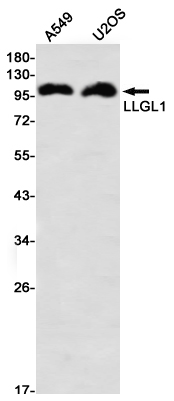LLGL1 Rabbit mAb
- SPECIFICATION
- CITATIONS
- PROTOCOLS
- BACKGROUND

Application
| WB, IP |
|---|---|
| Primary Accession | Q15334 |
| Reactivity | Human |
| Host | Rabbit |
| Clonality | Monoclonal Antibody |
| Calculated MW | 115418 Da |
| Gene ID | 3996 |
|---|---|
| Other Names | LLGL1 |
| Dilution | WB~~1/500-1/1000 IP~~N/A |
| Format | 50mM Tris-Glycine(pH 7.4), 0.15M NaCl, 40%Glycerol, 0.01% sodium azide and 0.05% BSA. |
| Storage | Store at 4°C short term. Aliquot and store at -20°C long term. Avoid freeze/thaw cycles. |
| Name | LLGL1 |
|---|---|
| Synonyms | DLG4, HUGL, HUGL1 |
| Function | Cortical cytoskeleton protein found in a complex involved in maintaining cell polarity and epithelial integrity. Involved in the regulation of mitotic spindle orientation, proliferation, differentiation and tissue organization of neuroepithelial cells. Involved in axonogenesis through RAB10 activation thereby regulating vesicular membrane trafficking toward the axonal plasma membrane. |
| Cellular Location | Early endosome membrane. Golgi apparatus, trans-Golgi network membrane. Golgi apparatus membrane. Cell projection, axon. Cytoplasm, cytoskeleton Note=Localized to the lateral membrane during the polarization and formation cell-cell contacts. Enriched in developing axons (By similarity). |
| Tissue Location | Expressed in brain, kidney, and muscle but is barely seen in heart and placenta. Down-regulated or lost in all cell lines and in most of the tumor samples analyzed. Loss was associated with advanced stage of the disease. |

Thousands of laboratories across the world have published research that depended on the performance of antibodies from Abcepta to advance their research. Check out links to articles that cite our products in major peer-reviewed journals, organized by research category.
info@abcepta.com, and receive a free "I Love Antibodies" mug.
Provided below are standard protocols that you may find useful for product applications.
If you have used an Abcepta product and would like to share how it has performed, please click on the "Submit Review" button and provide the requested information. Our staff will examine and post your review and contact you if needed.
If you have any additional inquiries please email technical services at tech@abcepta.com.













 Foundational characteristics of cancer include proliferation, angiogenesis, migration, evasion of apoptosis, and cellular immortality. Find key markers for these cellular processes and antibodies to detect them.
Foundational characteristics of cancer include proliferation, angiogenesis, migration, evasion of apoptosis, and cellular immortality. Find key markers for these cellular processes and antibodies to detect them. The SUMOplot™ Analysis Program predicts and scores sumoylation sites in your protein. SUMOylation is a post-translational modification involved in various cellular processes, such as nuclear-cytosolic transport, transcriptional regulation, apoptosis, protein stability, response to stress, and progression through the cell cycle.
The SUMOplot™ Analysis Program predicts and scores sumoylation sites in your protein. SUMOylation is a post-translational modification involved in various cellular processes, such as nuclear-cytosolic transport, transcriptional regulation, apoptosis, protein stability, response to stress, and progression through the cell cycle. The Autophagy Receptor Motif Plotter predicts and scores autophagy receptor binding sites in your protein. Identifying proteins connected to this pathway is critical to understanding the role of autophagy in physiological as well as pathological processes such as development, differentiation, neurodegenerative diseases, stress, infection, and cancer.
The Autophagy Receptor Motif Plotter predicts and scores autophagy receptor binding sites in your protein. Identifying proteins connected to this pathway is critical to understanding the role of autophagy in physiological as well as pathological processes such as development, differentiation, neurodegenerative diseases, stress, infection, and cancer.


